
Experimental Camp
The Experimental Camp of Bajos de Chila of UMAR is located on kilometer 128.1 of the federal highway Pinotepa Nacional-Puerto Escondido. The areas that are developed for research and practice for Animal Husbandry are:
Bovine Section
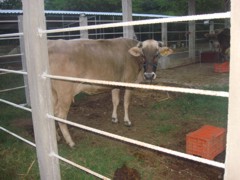
The Bovine Section has cattle that are cared for by UMAR staff.
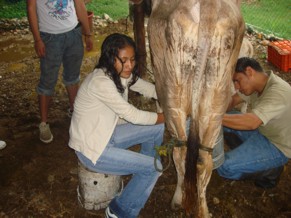 |
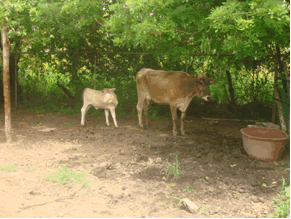 |
The Bovine Sections has cows and young bulls in the growth stage that are aimed at milk production, which will be used for the making of products such as cheese, yogurt, ice cream, among other products. These products are processed in the Technological Laboratory of Livestock at the university with the intention of developing research and practice for the students.
Dr. José Guadalupe Gamboa Alvarado
Bovine Area Manager
Experimental Camp
Bajos de Chila
alvarado@zicatela.umar.mx
Rabbit Research Area
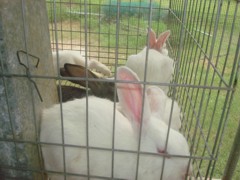
Rabbits are one of the preferred species for reproductive studies because of their physiological characteristics. They are used for student practices and preliminary studies of fodder species, digestibility, and behavior. Currently they are used in the process of testing the vegetable species that allow us to provide a balanced diet for reproductive animals.
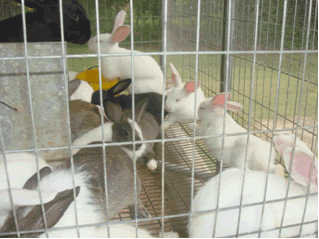
Rabbit production provides an interesting alternative for rural populations that have scarce native animal life. With rabbit production a family can eat low fat met often, thanks to the reproductive capacity which allows the female to become pregnant on the same day as she delivers, and she can stop breastfeeding after a month after birth. Also because of the characteristics of her digestive system, she can take in food very high in fiber.
The animals in the coastal region of Oaxaca that are used for this production are considered “creoles” with an influence from several breeds. It is a small animal which, according to our observations, weighs 2.4 kg (males) and 2.2 kg (female). Our first studies focused on the growth curve to determine the best time for slaughter, yield, and conversion into food.
More information:
Dr. José Luis Arcos García
jarcos@zicatela.umar.mx
Ostrich Research Area
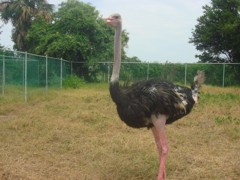
To achieve a high yield of the animal, we are currently working on the problems that are caused by artificial incubation, along with the problems associated with trying to feed these animals with regional produce. This can be problematic, due to fact that their feed can include very expensive ingredients.
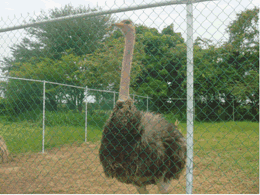 |
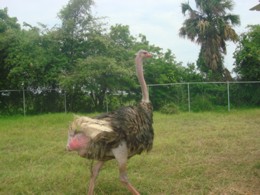 |
Ostriches have a remarkable ability to break down fiber compared to other birds and herbivores because of a highly specialized digestive system. Having done preliminary studies in vitro, we have obtained percentages of the use of the fiber greater than those found in ruminants. These studies coincide with several other studies on the topic, and explore the potential of using mainly natural forage as food for ostriches.
More information:
Dr. José Luis Arcos García
jarcos@zicatela.umar.mx
CECOREI-UMAR (Center for Conservation and Reproduction of Iguanas-UMAR)
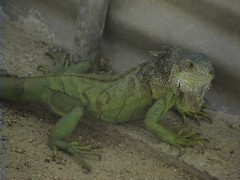
Objective: To establish a research nucleus to study the reproduction, exhibition, conservation of iguanas, that provides specimens of the black iguana (Ctenosaura pectinata) and green (iguana iguana) to communities and research centers interested in conservation and sustainable use; to generate basic and applied research in all the stages of development of the iguanas, concerning the nutritional, reproductive, genetic, and health aspects, and the general management of the species brought up in captivity.
The General Direction of Wildlife officially registered UMA on June 5, 2000 to the iguana tank of UMAR named IGUANA CONSERVATION AND REPRODUCTION CENTER – UMAR (CECOREI-UMAR), with the aim of managing the reproduction habits of the green (iguana iguana) and black (Ctensaura pectinata) iguana specimens. It is found on the Federal Highway Pinotepa Nacional to Puerto Escondido, Oaxaca, on kilometer 128.1, Bajos de Chila Mixtepec, Juquila, Oaxaca, zipcode 71981.
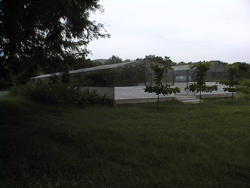 |
 |
The UMA is a Unit of Management for the conservation of wildlife (LGVS, 2002). It consists of registered land and installations that operate according to an approved management plan. It serves as a means of permanent follow-up study of the state of the habitat and populations and specimens that are managed.
GENERAL OBJECTIVES
To establish a research nucleus to study the reproduction, exhibition, conservation of iguanas, that provides specimens of the black iguana (Ctenosaura pectinata) and green (iguana iguana) to communities and research centers interested in conservation and sustainable use; to generate basic and applied research in all the stages of development of the iguanas, concerning the nutritional, reproductive, genetic, and health aspects, and the general management of the species brought up in captivity.
SPECIES SUBJECT TO MANAGEMENT
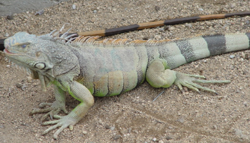
- Green Iguana: Linneaus (1758) explains that the green iguana is a reptile that is taxonomically classified in the Kingdom: Animal; Division: Chordate, Subdivision: Vertebrate; Class: Reptile; Subclass: Lepidosauria; Order: Squamata; Suborder: Lacertilia; Infraorder: Iguania; Family: Iguaninae; Genus: Iguana and Species: Iguana iguana. The common term for this species is “pance,” or “teyú,” or “gallina de palo (stick hen).” The male is often referred to as “garrobo” (Alvarado and Suazo, 1996).
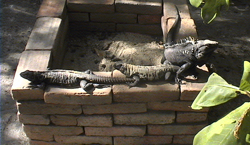
- Black iguana: the black iguana is classified in the following way – Kindom: Animal; Phylum: Chordate, Subphylum: Vertebrate, Class: Reptile, Subclass: Lepidosauria, Order: Squamata; Suborder: Lacertilian; Family: Iguanid; Subfamily: Iguaninae; Genus: Ctenosaura; species: pectinate (Oldham and Smith, 1975).
CECOREI-UMAR RESEARCH AREAS
- Incubation area: Recently collected eggs are identified, weighed and measured and taken to incubators. They are placed in under sand. Once incubated the eggs are kept in the incubation areas until they hatch. They are then taken to the growing area.
- Growing Area: a place where the iguanas are kept from the time they are hatched until they are nine months old.
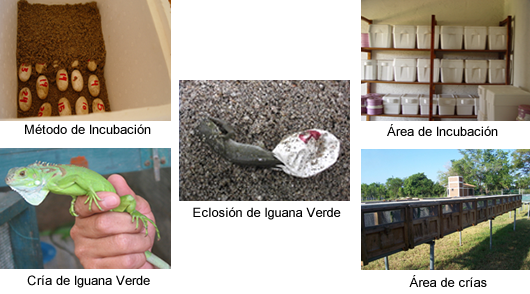 |
ACTIVITIES
- Students are accepted to do their theses, professional practice, and social service
- Student training
- Producer Training
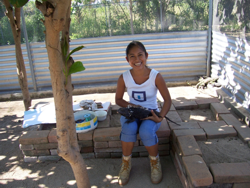 |
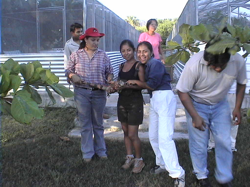 |
GUIDED TOURS
Please call the following contact person 15 days before your intended to make an appointment.
Dr. Juan Francisco Meraz Hernando, Academic Vice-Rector of Universidad del Mar, Puerto Escondido, Mixtepec, Juquila, Oaxaca 70989. Tel. 954 588 33 65.
SCHEDULE
Only tuesday and thursday 9:00 to 15:00
More Information:
Dr. José Luis Arcos García
jarcos@zicatela.umar.mx
Land Plots Section
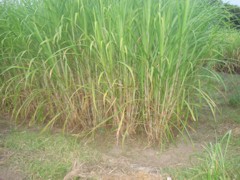
The purpose for establishing grass-forage land plots is mainly to learn about the adaptation mechanisms of grasses and determine which varieties are easy to propagate for forage use and which are most suitable for the region. The Land Plots Section also establishes the most efficient management methods for use of the grasses through grazing activity and/or through conservation of the grasses in silos or dry storage.
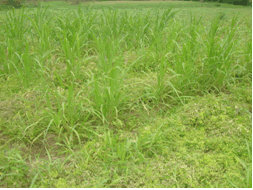 |
This proposal seeks to find solutions to a wide range of problems and limitations that come about in tropical livestock farming: the seasonal nature of forage productivity, inadequate grassland management, high incidence of plagues, insufficient knowledge about and use of germoplasm, among others.
This project also aims to generate information suitable for teaching and research ends, since the research involves the following subjects: Forage Botany, Forage Production, and Prairie and Pasture Management. These subjects are taught by Eliud Flores Morales, M.S., fmeliud@zicatela.umar.mx
Tropical Ovine Research Area

The module of tropical ovine research at the Puerto Escondido Campus has several fundamental objectives, such as conducting up-to-date research and supporting teaching practice in the Bachelor’s Degree in Animal Husbandry. It also serves as an option for students to do their social service and do their Bachelor’s and postgraduate thesis.
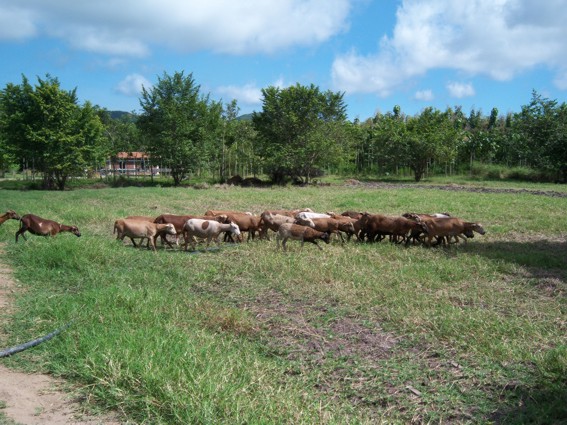 |
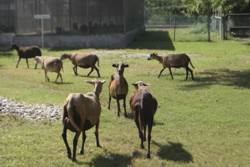 |
Currently this module is still in progress; suitable installations are being constructed for the species (81 animals). The Peliguey, Black Belly, (and their crossbeeds), Creole animals with Dorper features are the phenotypes that dominate. Currently two areas of research are being carried out: postpartum anestrum and seasonal reproduction of sheep.
Information:
Dr. José Luis Arcos García
Research Professor
jarcos@zicatela.umar.mx
Native Turkey Research Area
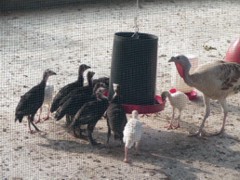
The study of native turkeys area began in 2004 at UMAR. Its purpose is to describe the characteristics of such animals, raise an experimental flock, and to become familiar with these species adaptation conditions, along with studying “backyard” (local) farming done in the area. We are studying these birds with the purpose of determining the potential use this genetically unique type of livestock that has been domesticated in this particular area of the country. Up to now this animal hasn’t been studied much nor has it been put to very good use.
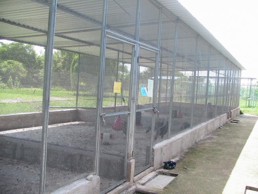 |
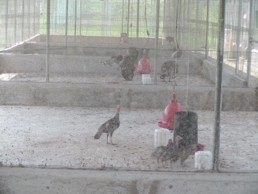 |
The experimental module of native turkeys has ten cages equipped to study extreme conditions in raising these birds and their “backyard” local farming. The birds that currently belong to the original flock come from different backyard farms in the coastal region of Oaxaca and some of them represent the main phenotypes of the domestic turkey.
 |
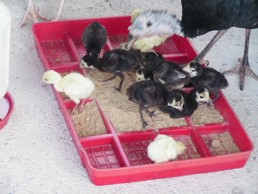 |
Currently this program is used for many areas of research. It is also used for theses and social service on the following topics: sanitation, genetics, nutrition, reproduction and physiology. It also is used for student field work for UMAR and other educational institutions.
Information:
Dr. José Luis Arcos García
jarcos@zicatela.umar.mx
Ciudad Universitaria, Santa María Huatulco, Oax., México C.P. 70989
Ciudad Universitaria, Carretera Vía Sola de Vega, Puerto Escondido, San Pedro Mixtepec, Juquila, Oax., México C.P. 71980
Pino Suárez #509 Col. Centro, Oaxaca de Juárez, Oax., México C.P. 68000








